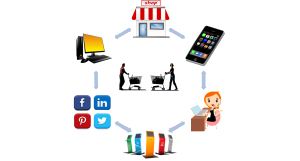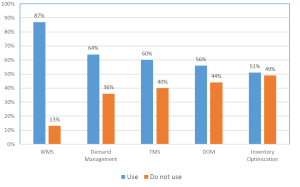Omni-Channel Retail: Isn’t It Really Just Commerce?
 Omni-channel is arguably the hottest topic in retail today. The evolution that has occurred over the years has been impressive, if only from a naming convention standpoint. First there was multi-channel, where a retailer sold goods through more than one channel. Then, it become cross-channel, where retailers tried to enable the customer to move between channels during the purchase journey. Now, there is omni-channel, where retailers are trying to provide full, seamless continuity across all channels of operation for the customer. So, in reality, omni-channel is commerce.
Omni-channel is arguably the hottest topic in retail today. The evolution that has occurred over the years has been impressive, if only from a naming convention standpoint. First there was multi-channel, where a retailer sold goods through more than one channel. Then, it become cross-channel, where retailers tried to enable the customer to move between channels during the purchase journey. Now, there is omni-channel, where retailers are trying to provide full, seamless continuity across all channels of operation for the customer. So, in reality, omni-channel is commerce.
The customer does not care about how front and back-end technologies and businesses processes are integrated across all channels of operation. They simply want to interact with a brand through a variety of channels, find the product they want, and have the order fulfilled when and how is most convenient. But that is the core problem for retailers. There are so many disparate technologies that need to come together in order to deliver this shopping experience. And for the most part, the technologies and business processes are not integrated, at least to the extent they need to be, to create a seamless customer experience.
Part of the upcoming research that I will be conducting includes a new omni-channel study. The focus of this research will be omni-channel fulfillment; how do orders generated across a variety of channels end up in the hands of the consumer? As more channels of interaction become active commerce channels, this becomes more challenging. The research will be comprised of two parts: a market study looking at the size of the omni-channel fulfillment market and an end-user study examining the business case of these technologies.
There are five major technologies that I will be examining: warehouse management systems (WMS), transportation management systems (TMS), distributed order management (DOM), inventory optimization, and demand management. From research that Clint Reiser and I collaborated on last year, one thing was noticeable about these technologies – they were not nearly as widespread as we would have expected. With the exception of WMS, each technology represented a significant technology gap, and a large opportunity for retailers to refine and improve their omni channel operations.
 A WMS’s primary mission is to manage a warehouse’s resources, including inventory, space, labor, equipment, tasks, and material flows. Essentially it is the backbone of moving goods from point A to point B. Not surprisingly, the majority of companies are using a WMS as part of their omni-channel operations. The increase in e-commerce has put added stress ion warehouses, as they are now replenishing stores while directly filling customer orders as well. These added complexities have made a WMS application critical for the new omni-channel paradigm.
A WMS’s primary mission is to manage a warehouse’s resources, including inventory, space, labor, equipment, tasks, and material flows. Essentially it is the backbone of moving goods from point A to point B. Not surprisingly, the majority of companies are using a WMS as part of their omni-channel operations. The increase in e-commerce has put added stress ion warehouses, as they are now replenishing stores while directly filling customer orders as well. These added complexities have made a WMS application critical for the new omni-channel paradigm.
TMS helps companies efficiently, reliably, and cost effectively move freight from origin to destination. TMS encompasses solutions for moving freight in all modes. The TMS processes include freight transported inbound or outbound, domestically or internationally, and using transportation assets the company owns or are owned by an outside service provider. The freight managed by a TMS ranges in size from parcels to bulk commodities.
DOM allows an organization to capture all information in the order management process across all relevant channels. This includes the entry of the order, sourcing, payments, and fulfillment. It also spans all channels of sales operations. The benefit is that it doesn’t matter where an order originates. All fulfillment channels have access to the information and the retailer can appropriately allocate the inventory depending on stock levels, demand requirements, and timing of fulfillment.
Inventory optimization enables retailers to balance their inventory levels with capital investment constraints. Clearly this is easier said than done. However, the use of multi echelon inventory optimization software can help retailers to identify the appropriate amount of stock needed at stores, warehouses, and distribution centers. Establishing these levels will help to free up available cash, thus making the business more profitable.
Finally, demand management is used to manage and forecast the demand of products. This allows organizations to properly allocate inventory to warehouses, distribution centers, and stores. The focus is on customer demand in the short term, and enables the retailer to respond to local events to change their inventory levels.
These five technologies represent the core technologies of my upcoming research on omni-channel fulfillment. But they are clearly only part of the puzzle when it comes to the overall omni-channel customer experience. The focus needs to be on setting appropriate expectation for the customer, and then fulfilling those expectations. Retailers need integrated technologies and business processes across channels to ensure that seamless experience. This integration will enable retailers to fulfill orders through the appropriate channels at the appropriate time. Then, we can finally move away from the pitfalls of discussing mulit-channel, cross-channel and omni-channel retailing. We can simply call it what it is: commerce.
your article is very nice it is very helpful for all people thank you very much for share this information.
ReplyDeleteWarehousing and Distribution Companies | Warehousing and Logistics Companies
Great explanation of omnichannel retailing
ReplyDelete